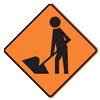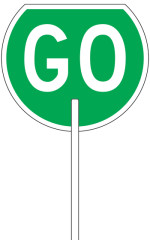Road repair crews often work on roads to keep them in good condition. This means you’ll sometimes come across heavy vehicles, machinery and workers on the road, which you must be careful around.
The road surface itself can also be dangerous when under repair, as it may be uneven or have new seal.
When you see a roadworks sign, always slow down and be ready to stop.
If there are roadworks on the road ahead, it’ll always be clearly signposted.
Slow down and read the signs. They will prepare you for the particular hazards you’re about to face.
Two of the signs commonly used to indicate roadworks are shown below.

Roadworks ahead

Flooding ahead
Because it can be dangerous to drive through roadworks or on new seal, temporary speed limit signs are often posted. You must not drive faster than the speed shown on the temporary speed limit sign.
Road repair crews may sometimes need to stop traffic. They may use temporary traffic signals or hand-held stop/go signs (shown below) to do this.

Stop before reaching the sign

You may move forward carefully
Follow all directions given to you, otherwise you could be involved in a serious crash.
Important!Crashes can happen when drivers ignore roadworks warning signs and temporary speed limits. Don’t ignore these warnings. You don’t know what’s ahead, so slow down and take care. |
When a road is closed or being maintained, you may see detour signs showing you an alternative way around the road block.

Detour ahead sign
Detour direction sign
You should follow the direction signs and expect to see them when approaching and leaving intersections. Take note of the shape and colour of the symbol on detour signage as one detour may pass through another.
When roads or lanes are being maintained, a truck with a message board on it, called an attenuator, is often used. It directs traffic to an open lane in advance of roadworks. Slow down and follow the arrow.

An attenuator